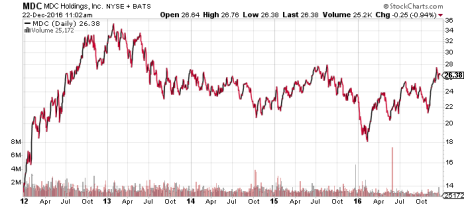The homebuilding industry has featured prominently in my stock picks in 2016 because a high percentage of housing stocks, including D.R. Horton (DHI), PulteGroup (PHM) and Toll Brothers (TOL), offer good earnings growth at attractive valuations. But I especially like one undervalued small-cap growth stock in the industry. More on that in a minute.
The homebuilding industry is expected to fare well under the new political administration, as investors widely perceive a coming economic boom that benefits workers’ abilities to purchase homes.
While it is true that the Federal Reserve recently increased interest rates, and is expected to do so repeatedly in the coming years, let’s put these rate increases in perspective. The Fed funds rate was 8.74% when I joined the investment business in 1989. Today it’s at 0.66%—hardly a number to dissuade a home purchase.
[text_ad]
Today I’m recommending a company that’s based in my home state of Colorado, M.D.C. Holdings (MDC), a U.S. homebuilder of single-family detached homes operating under the brand name Richmond American Homes. M.D.C. is involved in land acquisition and development, home construction, sales and marketing in a dozen east coast, west coast and mountain states. Its west coast and mountain state geographies account for 80% of the company’s annual revenue. The company also provides related financial services, including mortgages, insurance and title services.
M.D.C.'s revenue rose 12.6% to $1.9 billion in 2015, and is expected to rise another 18% and 9% in 2016 and 2017, spurred by volume and pricing increases. MDC’s average home price should end 2016 around $446,000. The company’s backlog at the end of third-quarter 2016 amounted to 3,448 homes valued at $1.6 billion. Labor shortages throughout the U.S. homebuilding industry are slowing the pace of construction.
Wall Street’s consensus estimates project M.D.C.'s earnings per share (EPS) will finish fiscal 2016 with 50% growth (December year-end). Despite the huge 2016 EPS growth rate, the number has barely fluctuated this year, coming down just four percentage points from consensus estimates dated December 2015. Keeping the relative accuracy of M.D.C.'s earnings projections in mind, the projected 2017 EPS growth rate has steadily increased from 17.7% to 27.1% over the last nine months.
The 2017 price/earnings ratio (P/E) is 10.9. MDC does not have a predictable long-term P/E range, but in 2014 and 2015—years when the company experienced relatively slow earnings growth—the P/E ranged between 18 and 25.
MDC’s dividend has been $0.95 per year for over a decade. The current dividend yield is 3.6%—the highest among its homebuilding peers. In addition, the company recently paid its shareholders a 5% stock dividend.
The company has a long-term debt-to-capitalization ratio of 40%, below the average 50% ratio among its peer group. 80% of MDC shares are held by financial institutions.
MDC is an extremely undervalued small-cap growth stock.
Housing stocks can be volatile. The share price was much higher a dozen years ago, so for point of reference, it’s most useful to look at a five-year price chart for help in determining the stock’s next most-likely move.
MDC rose to 28 repeatedly since late 2013, and will likely trade between 23 and 28 in the very short term. Now that the stock market is viewing housing and construction stocks more favorably, MDC could garner the buying support it needs to break past 28. When that happens, MDC could rise to 34 before meeting additional upside resistance.
I hope you take advantage of this undervalued small-cap growth stock at this price.
Wishing you and yours a happy Christmas and a wonderful new year!



